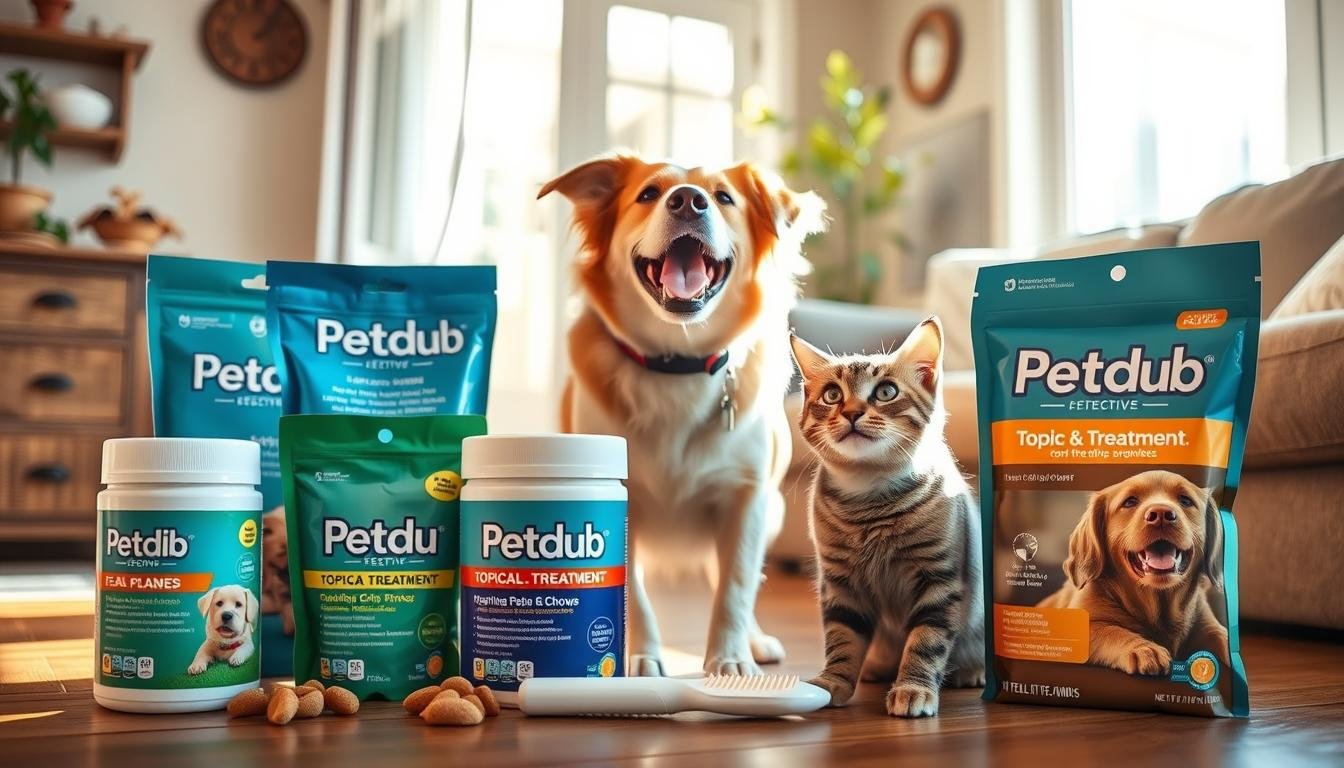Did you know fleas can lay up to 50 eggs a day? This leads to a huge increase in their numbers in just a few weeks. Flea infestations can be a big problem for pet owners. They cause discomfort, skin irritation, and can even spread diseases.
In this guide, we’ll look at different pet flea treatments to keep your pets happy and healthy. We’ll cover topical flea solutions, oral flea medications, and natural flea remedies. You’ll learn how to fight flea infestations and stop them from coming back.
Key Takeaways
- Fleas can lay up to 50 eggs per day, leading to rapid population growth.
- Effective pet flea treatments include topical solutions, oral medications, and natural remedies.
- Understanding the risks of flea infestations and recognizing the signs is crucial for taking action.
- Integrating multiple treatment methods can provide a comprehensive approach to flea control.
- Consulting with your veterinarian is recommended to ensure the right fit for your pet’s needs.
Understanding the Importance of Flea Control
Fleas can be a big problem for our pets and homes. They can make our pets sick and even spread diseases. It’s important to control fleas to keep our pets healthy and our homes safe.
The Risks of Flea Infestations
Fleas can cause serious health issues. They can spread diseases like typhus and plague. Flea bites also make pets and people itch and can lead to infections.
Signs of a Flea Problem in Your Home
Spotting a flea problem early is key. Look out for these signs:
- Excessive scratching or licking by your pet
- Visible fleas or flea dirt (dried blood) on your pet’s fur
- Small, dark specks on your pet’s bedding or around the home
- Seeing fleas jumping on your pet or in your living spaces
Acting fast to get rid of fleas is vital. It helps keep your family and pets safe and healthy.

Exploring Topical Flea Solutions
Topical flea treatments are a great way to keep our pets flea-free. These spot-on applications and sprays are easy to use. They help our pets feel better and stay healthy.
Spot-on treatments are very popular. You apply them to your pet’s skin, usually between the shoulder blades. They kill fleas and prevent them from coming back. Many also have insect repellents to protect against other pests.
Topical sprays are another good option. You spray them on your pet’s coat for full coverage. They work like spot-on treatments but are easier to apply, especially for pets that don’t like the spot-on method.
| Product | Active Ingredient | Application Method | Efficacy |
|---|---|---|---|
| Frontline Plus Spot-On | Fipronil and (S)-methoprene | Spot-on application | Highly effective in killing fleas and ticks |
| Advantage II Topical Spray | Imidacloprid and pyriproxyfen | Spray application | Proven to kill fleas and prevent their development |
| Adams Plus Flea & Tick Spray | Pyrethrin and (S)-methoprene | Spray application | Effective in controlling fleas, ticks, and their larvae |
It’s crucial to use topical flea solutions as directed. Make sure they’re right for your pet’s size, breed, and health. By choosing the right product and using it correctly, we can protect our pets from fleas.
Oral Flea Medications: A Convenient Approach
Oral flea medications are a simple way to keep your pets flea-free. They come in food or chewable treats, making it easy and stress-free. We’ll look at what’s in these medications and how to use them safely and effectively.
Understanding the Active Ingredients
These medications have ingredients that kill fleas and stop them from reproducing. You’ll often find:
- Spinosad, a natural insecticide from soil bacteria, that kills adult fleas.
- Nitenpyram, a fast-acting insecticide that quickly kills adult fleas on your pet.
- Afoxolaner, a newer ingredient that paralyzes and kills fleas by affecting their nervous system.
These ingredients help control fleas, getting rid of them and preventing new ones.
Dosage and Administration Guidelines
It’s key to follow the dosage and administration guidelines for oral flea medications. Your pet’s weight, age, and health will determine the right amount. These medications are usually given monthly or as your vet advises to keep your pet protected.
“Oral flea medications offer a convenient and effective way to eliminate fleas and prevent future infestations, as they are administered directly through your pet’s food or as a chewable treat.”
It’s important to give the right amount and follow the instructions to keep your pet safe. Always talk to your vet about flea control products and your pet’s health.
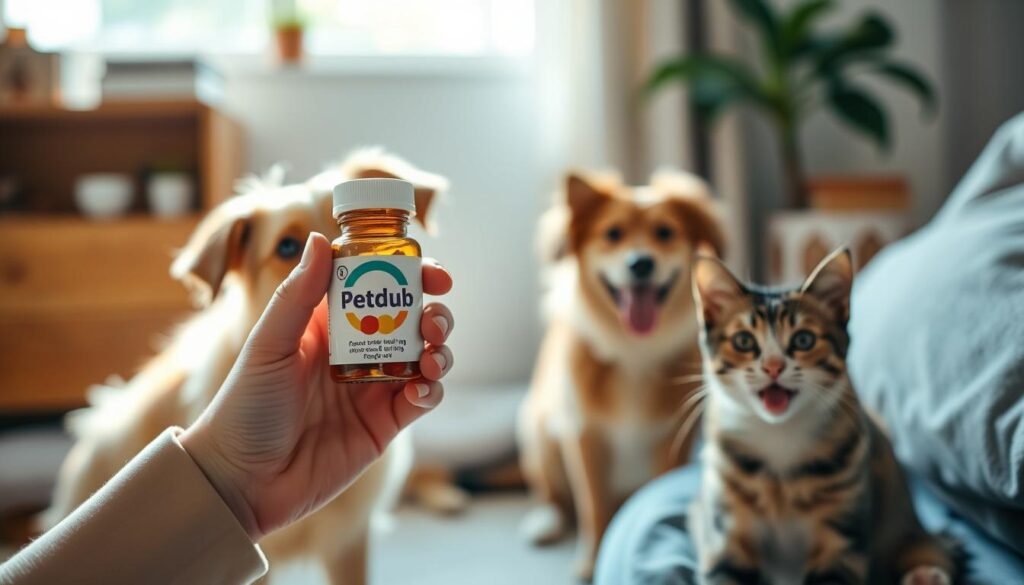
Natural Flea Remedies: Safe and Effective Options
Many pet owners prefer natural ways to fight fleas. There are several safe and effective options. We’ll look at natural flea remedies and how they help pets and homes.
Essential oils are a popular choice. Oils like cedarwood, lemongrass, and peppermint repel fleas. To use them, apply a few drops to your pet’s collar or mix with a carrier oil and massage into their fur.
- Cedarwood oil: Helps repel fleas and ticks
- Lemongrass oil: Possesses insecticidal properties
- Peppermint oil: Deters fleas and other pests
Herbs and spices are another natural option. Rosemary, thyme, and lavender can be used in bedding or around living areas. You can also make flea sprays by steeping these herbs in water and applying them to your pet’s coat.
| Herb | Benefits |
|---|---|
| Rosemary | Repels fleas and ticks |
| Thyme | Possesses insecticidal properties |
| Lavender | Helps calm and soothe pets |
Using natural flea remedies can help manage infestations safely. Always talk to your vet before trying new treatments to make sure they’re right for your pet.
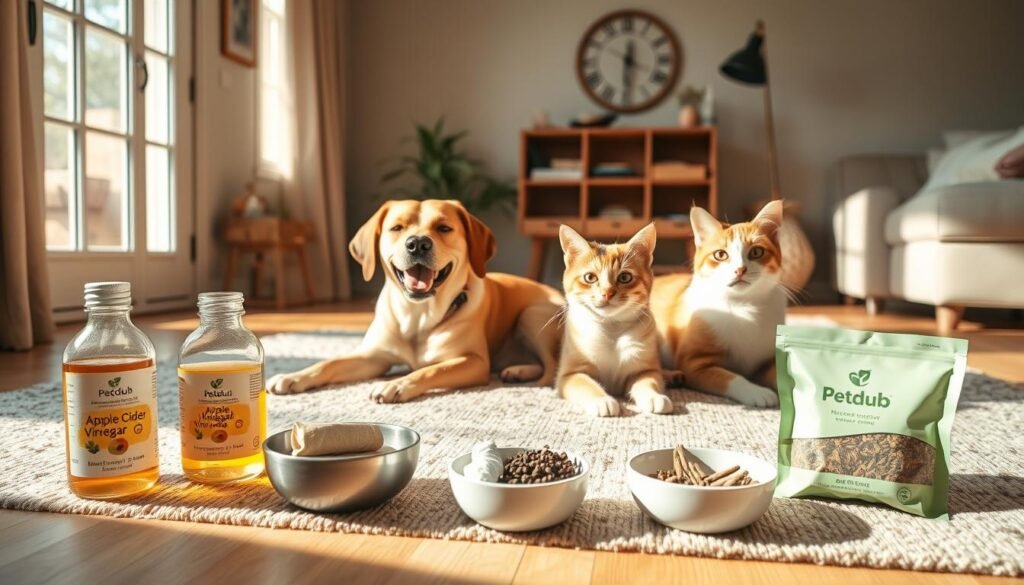
Flea Collars: A Practical Solution
Dealing with fleas can be really frustrating for pet owners. But, flea collars offer a simple solution. These collars keep your furry friend safe from fleas all the time. They are easy to use and very effective.
Choosing the Right Flea Collar
When picking a flea collar, think about what’s inside and how safe it is. Look for ones with ingredients like imidacloprid or flumethrin. These ingredients kill and keep fleas away. Also, make sure the collar fits well without being too tight.
Here are some things to think about when choosing a flea collar:
- Active Ingredients: Choose collars with EPA-registered ingredients like imidacloprid or flumethrin. They are good at killing and keeping fleas away.
- Adjustability: Pick a collar that can be adjusted. It should fit your pet’s neck comfortably and safely.
- Waterproof: Find collars that are water-resistant or waterproof. They should work even when your pet gets wet.
- Safety Features: Look for collars with safety features like breakaway clasps. They help prevent accidents.
By looking at these factors, you can find a flea collar that works well. It will keep your pet safe and comfortable.

“Flea collars are a game-changer when it comes to flea control. They provide a convenient and long-lasting solution that can keep your pet comfortable and pest-free.”
Flea Sprays and Powders: Treating Your Home
To get rid of fleas, treating your pet and home is key. We’ll look at flea sprays and powders. You’ll learn how to use them safely and effectively.
Application Methods and Precautions
Flea sprays and powders are strong tools against fleas. They target fleas in your home, helping your pet’s treatments work better.
Follow the instructions closely when using these products. Flea sprays should cover carpets, furniture, and other hiding spots. Flea powders go in cracks, crevices, and pet beds to stop fleas.
Protect your family and pets when using these flea control products. Make sure the area is well-ventilated and wear gloves. Keep children and pets away until the product is dry or vacuumed up.
| Flea Spray | Flea Powder |
|---|---|
| Targets fleas on surfaces | Disrupts flea life cycle in cracks and crevices |
| Thorough coverage of carpets, furniture, and other areas | Sprinkle in pet bedding and hard-to-reach spaces |
| Ensure proper ventilation and avoid direct skin contact | Keep away from children and pets until dry or vacuumed |
Using flea sprays and flea powders with other treatments can get rid of fleas. This keeps your pets and family safe and happy.
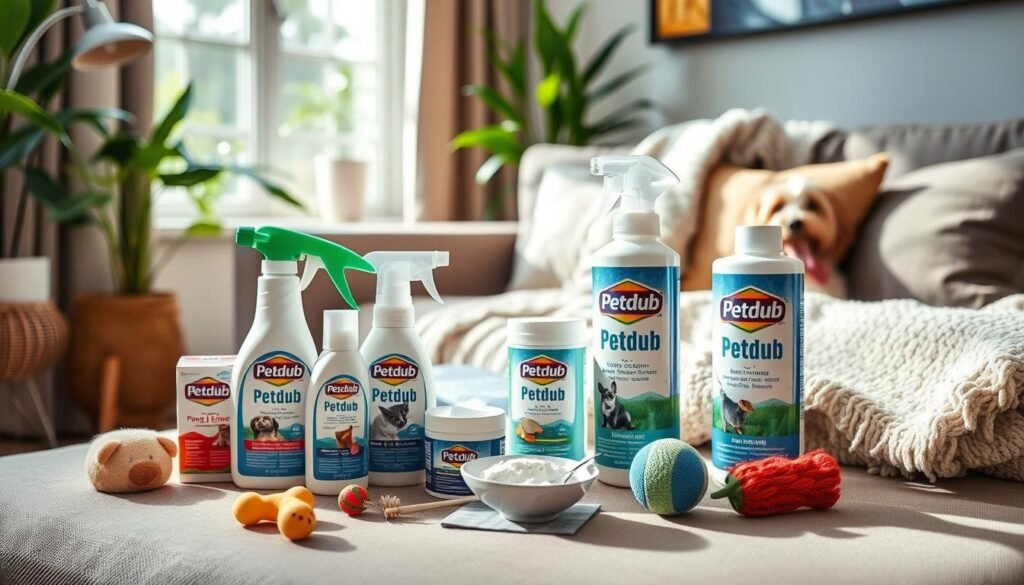
Flea Shampoos: A Deep Cleansing Solution
Flea shampoos are a strong tool against fleas on your pet. They clean deeply and remove fleas from your pet’s coat. Knowing the benefits and what to look for in flea shampoos helps keep your pet healthy and happy.
Shampoos with insecticides like permethrin or pyrethrin kill adult fleas and their eggs. Some also have oatmeal or aloe vera to soothe skin irritation from flea bites. Using these shampoos with other flea control methods keeps your pet well.
It’s important to follow the shampoo instructions and talk to your vet. This ensures the shampoo is right for your pet. Using it with other flea prevention methods keeps your pet safe and comfortable.
| Flea Shampoo | Key Ingredients | Recommended For |
|---|---|---|
| Veterinary Formula Clinical Care Antiseptic and Antifungal | Chlorhexidine Gluconate, Miconazole Nitrate | Dogs and Cats |
| Adams Plus Flea and Tick Shampoo with Precor | Pyrethrin, Piperonyl Butoxide | Dogs |
| Vet’s Best Flea and Tick Relief Shampoo | Peppermint Oil, Eugenol | Dogs and Cats |
Adding flea shampoos to your pet’s grooming routine helps keep them healthy and happy. It tackles flea infestations directly, giving your pet the relief and comfort they need.
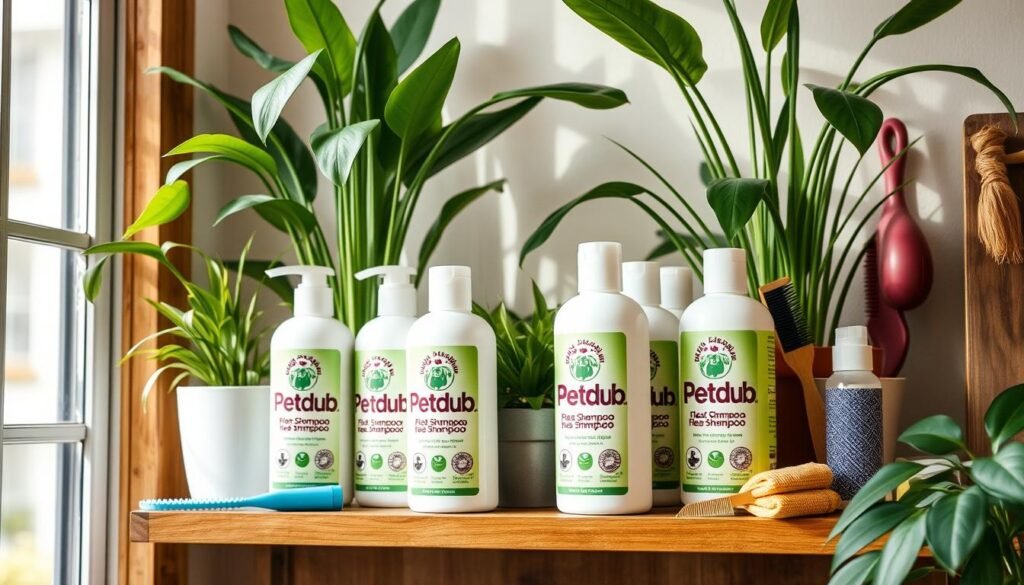
“Flea shampoos are a crucial component of a comprehensive flea control strategy, providing a deep clean and relief for our pets.”
Integrated Pest Management: A Comprehensive Approach
Controlling fleas needs a mix of methods, called integrated pest management. This way, we can keep our pets and homes flea-free for good.
Combining Multiple Treatment Methods
For flea control, mixing different methods works better than one alone. This might include topical flea solutions, oral meds, and cleaning the environment. We vacuum, wash bedding, and use flea traps too.
This multi-step plan attacks fleas at every stage. It kills adult fleas and their eggs or larvae. This stops fleas from coming back and gives a better solution.
| Flea Control Method | Description |
|---|---|
| Topical Solutions | These integrated pest management products are applied directly to the pet’s skin, providing long-lasting protection and killing adult fleas. |
| Oral Medications | Ingested by the pet, these flea control products work systemically to eliminate fleas and prevent future infestations. |
| Environmental Treatments | Vacuuming, washing bedding, and using flea traps help to remove eggs, larvae, and adult fleas from the pet’s living environment. |
By using these integrated pest management methods together, we can fight fleas from all sides. This leads to lasting flea control for our homes and pets.
“Effective flea control requires a comprehensive approach that targets all stages of the flea life cycle.”
Remember, with integrated pest management, being consistent and careful is crucial. Regular use of a mix of flea control methods keeps your home and pets flea-free.
Pet Flea Treatments: Finding the Right Fit
Protecting our pets from fleas can feel overwhelming with so many options. It’s key to find a treatment that fits our pet’s needs and our preferences. We’ll look at what to consider when choosing the best flea control for your pet.
First, know your pet’s size, age, and health. This helps pick a safe and effective flea treatment. For example, pet flea treatments for small dogs might not work for big ones. Some flea control products aren’t good for puppies or kittens.
Think about how you want to apply the treatment. Some like topical solutions, while others prefer oral meds or collars. Each has its own benefits and drawbacks. It’s smart to research and decide what’s best for your pet and your life.
- Topical treatments: Easy to apply, often provide long-lasting protection
- Oral medications: Convenient and effective, but may need more frequent use
- Flea collars: Offer continuous protection, but might not be right for all pets
Lastly, check the safety and effectiveness of the pet flea treatments. Choose products approved by the EPA or FDA. Always talk to your vet for advice tailored to your pet.
“The right flea treatment can make all the difference in keeping your pet happy and healthy.”
By researching and comparing flea control products, you can find the best one for your pet. Remember, your pet’s health and happiness should always come first.
Preventing Future Flea Infestations
Keeping your home clean and flea-free is key to avoiding future infestations. Regular vacuuming and washing pet bedding are important steps. These actions help keep your pets happy and healthy. For more information, visit this link.
Vacuum Regularly
Vacuuming your home often, especially where pets hang out, can remove fleas. Focus on carpets, furniture, and hidden spots where fleas like to hide.
Wash Pet Bedding Frequently
Wash your pet’s bedding in hot, soapy water weekly. This kills fleas and their eggs, stopping the cycle and preventing future problems.
Use Flea Control Products
Using flea control products adds extra protection against fleas. Talk to your vet to find the best flea control products for your pet and home.
“Preventing future flea infestations is crucial for the long-term health and well-being of your pets.”
By taking these steps, you can keep your home and pets flea-free. A proactive approach is essential for a flea-free environment for your family and pets.
| Flea Control Measure | Benefits |
|---|---|
| Regular Vacuuming | Removes flea eggs, larvae, and adult fleas from carpets, furniture, and crevices. |
| Frequent Washing of Pet Bedding | Eliminates fleas and flea eggs, breaking the life cycle. |
| Use of Flea Control Products | Provides an additional layer of protection against future infestations. |
Consulting Your Veterinarian
Keeping your furry friend flea-free is important. A veterinarian is key in this fight. Each pet is different, so what works for one might not work for another.
Our vet experts suggest a consultation to find the best flea control for your dog. They consider your pet’s age, health, and any allergies or sensitivities.
Your vet might suggest a mix of treatments. This could include topical solutions, oral meds, and home treatments. These aim to get rid of fleas on your pet and in your home.
- Your vet can pick the right flea control products for your dog’s needs.
- They’ll tell you how to use them correctly to avoid bad reactions.
- They’ll also tell you how often and for how long to treat to keep fleas away.
By teaming up with your consulting veterinarian, you can be sure your pet’s flea control is just right. This keeps them happy, healthy, and flea-free.
“Partnering with your veterinarian is the best way to ensure your pet’s flea control needs are met effectively and safely.”
| Benefit | Description |
|---|---|
| Personalized Guidance | Your veterinarian can recommend the most suitable flea control products based on your pet’s individual needs and health status. |
| Proper Usage Instructions | They can provide guidance on the correct dosage and application of treatments to ensure maximum effectiveness and safety. |
| Comprehensive Approach | Veterinarians can suggest a multi-faceted flea control strategy, addressing both your pet and the environment to achieve complete flea elimination. |
Can Dogs Eat Carrots? A Healthy Canine Treat Guide
Conclusion
Keeping our pets happy and healthy is a big job. Managing flea infestations is a key part of it. We’ve looked at many pet flea treatments and flea control products.
There are many choices, like topical solutions, oral meds, natural remedies, and flea collars. Each one has its own benefits. Knowing how they work and how to use them helps keep our pets safe.
Keeping our homes clean and watching for flea signs is important. If we’re unsure, talking to our vets is a great idea. They help us make the best choices for our pets.

